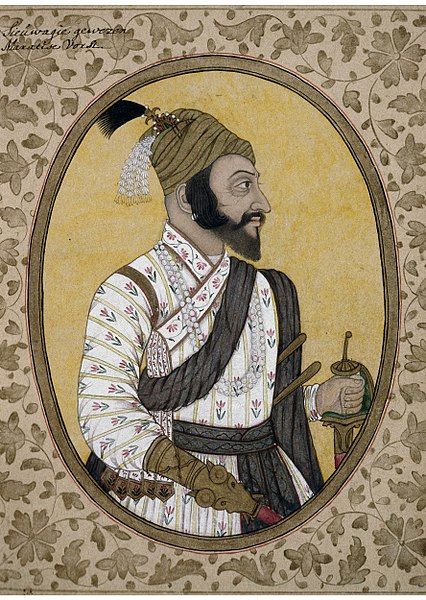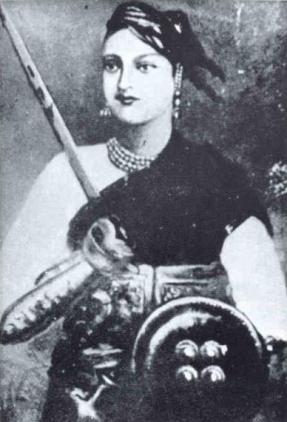Tipu Sultan (born Sultan Fateh Ali Sahab Tipu,[2] 20 November 1750 – 4 May 1799), also known as Tipu Sahab or the Tiger of Mysore,[3] was the ruler of the Kingdom of Mysore based in South India and a pioneer of rocket artillery.[4][5][6] He introduced a number of administrative innovations during his rule, including a new coinage system and calendar,[7] and a new land revenue system which initiated the growth of the Mysore silk industry.[8] He expanded the iron-cased Mysorean rockets and commissioned the military manual Fathul Mujahidin. He deployed the rockets against advances of British forces and their allies during the Anglo-Mysore Wars, including the Battle of Pollilur and Siege of Seringapatam.[citation needed]
Napoleon Bonaparte, the French commander-in-chief, sought an alliance with Tipu Sultan. Both Tipu Sultan and his father used their French-trained army in alliance with the French in their struggle with the British,[9][10] and in Mysore's struggles with other surrounding powers, against the Marathas, Sira, and rulers of Malabar, Kodagu, Bednore, Carnatic, and Travancore. Tipu's father, Hyder Ali, rose to power and Tipu succeeded him as the ruler of Mysore upon his father's death in 1782. He won important victories against the British in the Second Anglo-Mysore War and negotiated the 1784 Treaty of Mangalore with them after his father died from cancer in December 1782 during the Second Anglo-Mysore War.Tipu's conflicts with his neighbours included the Maratha–Mysore War which ended with the signing of the Treaty of Gajendragad.[11] The treaty required that Tipu Sultan pay 4.8 million rupees as a one-time war cost to the Marathas, and an annual tribute of 1.2 million rupees in addition to returning all the territory captured by Hyder Ali.[12][13]
Tipu remained an implacable enemy of the British East India Company, sparking conflict with his attack on British-allied Travancore in 1789. In the Third Anglo-Mysore War, he was forced into the Treaty of Seringapatam, losing a number of previously conquered territories, including Malabar and Mangalore. He sent emissaries to foreign states, including the Ottoman Empire, Afghanistan, and France, in an attempt to rally opposition to the British.
In the Fourth Anglo-Mysore War, Combined force of British East India Company supported by the Marathas & Nizam of Hyderabad . They defeated Tipu, and he was killed on 4 May 1799 while defending his fort of Seringapatam.
In post-colonial Indian subcontinent, he is applauded as a secular[14][15][16][17][18] ruler who fought against British colonialism,[19][20] but has also been criticized for his repression of Hindus of Malabar and Christians of Mangalore for both religious and political reasons.
Early years
Childhood
Tippu's birthplace, Devanahalli.
Tipu sultan confronts his opponents during the Siege of Srirangapatna.
Tipu Sultan was born on 20 November 1750 (Friday, 20th Dhu al-Hijjah, 1163 AH) at Devanahalli,[1] in present-day Bangalore Rural district, about 33 km (21 mi) north of Bangalore city. He was named "Tipu Sultan" after the saint Tipu Mastan Aulia of Arcot. Being illiterate, Hyder was very particular in giving his eldest son a prince's education and a very early exposure to military and political affairs. From the age of 17 Tipu was given independent charge of important diplomatic and military missions. He was his father's right arm in the wars from which Hyder emerged as the most powerful ruler of southern India.[27]
Tipu's father, Hyder Ali, was a military officer in service to the Kingdom of Mysore who had become the de facto ruler of Mysore in 1761 while his mother Fatima Fakhr-un-Nisa was the daughter of Mir Muin-ud-Din, the governor of the fort of Kadapa. Hyder Ali appointed able teachers to give Tipu an early education in subjects like Urdu, Persian, Arabic, Kannada, Quran, Islamic jurisprudence, riding, shooting and fencing.[1][28][29][30]
Early military service
A flintlock blunderbuss, built for Tipu Sultan in Srirangapatna, 1793–94. Tipu Sultan used many Western craftsmen, and this gun reflects the most up-to-date technologies of the time.[31]
Tipu Sultan was instructed in military tactics by French officers in the employment of his father. At age 15, he accompanied his father against the British in the First Mysore War in 1766. He commanded a corps of cavalry in the invasion of Carnatic in 1767 at age 16. He also distinguished himself in the First Anglo-Maratha War of 1775–1779.[32]
Alexander Beatson, who published a volume on the Fourth Mysore War entitled View of the Origin and Conduct of the War with Tippoo Sultaun, described Tipu Sultan as follows: "His stature was about five feet eight inches; he had a short neck, square shoulders, and was rather corpulent: his limbs were small, particularly his feet and hands; he had large full eyes, small arched eyebrows, and an aquiline nose; his complexion was fair, and the general expression of his countenance, not void of dignity".






0 Comments